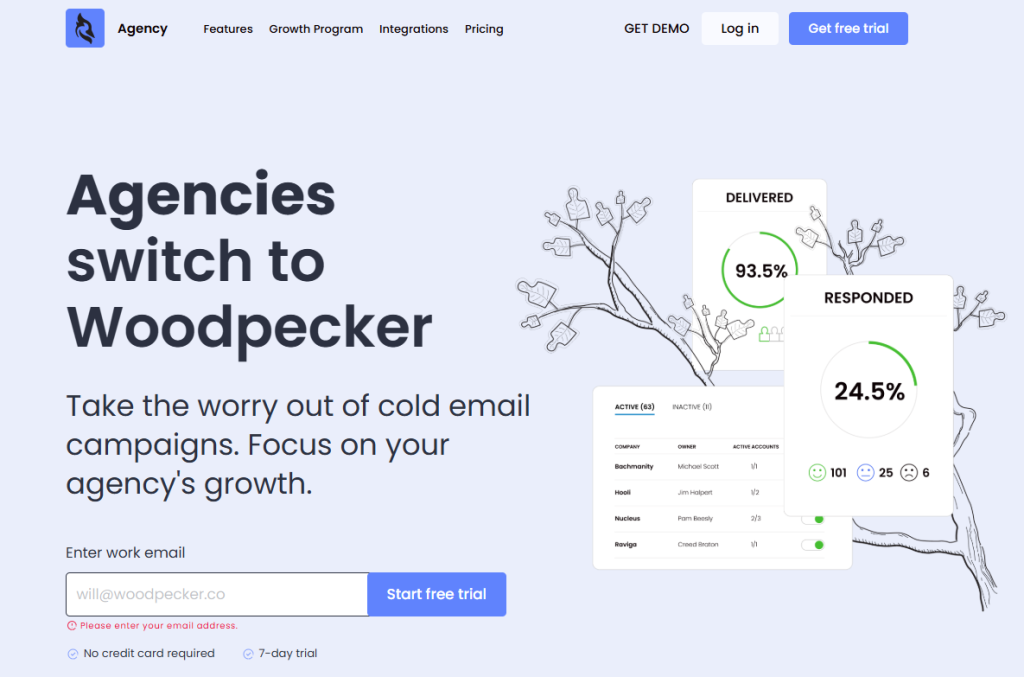Running an SEO agency in 2025 feels tougher than ever.
According to recent reports, 58% of SEOs say competition has grown sharply due to AI-powered tools, making it harder to stand out.
At the same time, the global SEO services market is projected to grow from $82.3 billion in 2023 to $143.9 billion by 2030. The industry is booming, but margins are tighter, sales cycles are longer, and agencies can’t rely on inbound leads alone.
To keep pipelines healthy, firms need multiple, reliable lead sources. 61% of marketers already rank lead generation as their biggest challenge, while 42% of companies struggle with low-quality leads.
That’s why more agencies are adopting lead generation software and structured systems – from outbound lead generation tools to lead capture forms and interactive content – to build predictable flows of qualified prospects.
The best tools go beyond collecting contact details.
They use automation and, increasingly, AI to help sales and marketing teams find quality leads, score them, and guide them toward sales calls that close.
Agencies that combine the right mix of software can generate more leads, keep their sales process moving, and stay competitive despite market disruption.
What is the right mix though? Let’s find out together.
Why traditional SEO lead generation isn’t enough anymore
A few years ago, agencies could grow by publishing blog posts, ranking for keyword research topics, and waiting for site visitors to trickle into the funnel. Referrals filled the gaps, and the pipeline stayed healthy.
Today that model is breaking down.
AI Overviews have cut clickthrough rates on position #1 results by 34.5%, and predictions show organic traffic could fall by 25% by 2026. Even agencies with strong search engine optimization strategies are feeling the squeeze.
Meanwhile, 62% of SEO professionals say AI search makes up less than 5% of their revenue, leaving them highly exposed to traditional traffic volatility.
Paid ads haven’t solved the gap either. Costs are rising, and longer sales cycles mean the return is harder to justify.
Cold outreach is also saturated, with inboxes full and declining response rates.
Agencies that stick to the old playbook risk wasting money and failing to generate SEO leads.
Smarter, multi-channel systems are now the baseline. Data shows omnichannel outreach (email, LinkedIn, calls) produces 40% higher response rates and 31% lower costs per lead. This is proof that diversification is no longer optional.
What to look for in lead generation tools for SEO marketing agencies
Not every platform that promises to “generate leads” is built for agency work. A good tool should do more than grab an email address. It should help your sales team move qualified prospects through the funnel and into real conversations.
Here are key factors to evaluate:
Lead quality over volume
With 42% of businesses citing poor lead quality as a top challenge, focus on tools that deliver high value leads, not bloated lists. Ten hot leads are worth more than 1,000 unqualified names.
Ease of use and integration
Your sales and marketing teams already juggle CRMs, dashboards, and reporting. The right marketing tools should integrate smoothly, reduce friction, and save time without complex setups.
Cost and pricing plans
From free lead generation tools to advanced outbound lead generation software, compare what each basic plan or paid plan delivers against revenue impact. Outsourcing or specialized software can cut sales costs by up to 70% compared to in-house prospecting.
Credibility and branding
88% of B2B buyers trust agencies more when they share educational content. Choose tools that help you demonstrate authority and capture contact leads, as well as build brand credibility in front of your target audience.
When these boxes are checked, agencies can keep inbound lead generation meaningful and balance it with outreach campaigns, so growth doesn’t depend only on shrinking organic traffic – and without repeating the mistakes that leave 61% of marketers struggling to generate enough leads.
Tool set #1: outreach & cold email for more qualified leads
Cold email still works for agencies, but only when it’s done right. That means staying out of spam folders, personalizing messages, and managing follow-ups at scale.
This is where Woodpecker stands out as a cold email tool built with agencies in mind.
Woodpecker combines several features into one platform:
- Free email verification so you don’t waste time on invalid addresses.
- Free warm-up that automatically builds your sender reputation.
- Deliverability monitor and adaptive sending to predict issues and avoid hitting provider limits.
- Inbox rotation and domain audits so campaigns stay safe even as volumes grow.
For SEO firms, the agency panel is a big advantage. It lets you manage multiple client campaigns in one place, keeping control of sequences, results, and deliverability across accounts.
With add-ons, you can extend campaigns to LinkedIn by adding invites, profile visits, or messages alongside your email steps. This helps connect cold outreach with broader sales and marketing teams activity.
Setup is straightforward. You get domains and inboxes with SPF, DKIM, and DMARC pre-configured, run a quick warm-up, find B2B leads in Woodpecker’s database of over 1 billion contacts, and launch your first email marketing campaign. No credit card is needed to start the 7-day trial, and all features are unlocked.
Do’s and don’ts for SEO agencies using Woodpecker:
- Do personalize every step with snippets and condition-based campaigns.
- Do use lead scoring to focus on hot leads that fit your target niche.
- Don’t push generic “SEO audit” offers – this tactic is overused and often flagged.
- Don’t skip monitoring deliverability as one blocked domain can affect all campaigns.
Agencies that use Woodpecker effectively keep their sales pipeline management steady, reach more potential customers, and run outbound lead generation software in a way that feels personal, not spammy.

Tool set #2: content-driven SEO lead generation tools
Cold outreach is only part of the picture. Many agencies win high value leads by giving prospects a free resource that proves expertise.
Content-driven tools help you build those assets faster and turn anonymous site visitors into contact leads your sales team can nurture.
Quizzes and assessments
Interactive quizzes or assessments are powerful for SEO agencies because they combine lead capture with education.
Tools like Typeform or Outgrow let you create quick assessments such as “How healthy is your SEO?” or “Is your website optimized for conversions?”
Visitors get instant results, while your agency collects contact details for follow-up. The best part is that you already position yourself as a problem-solver before the first call.
Lead magnets and templates
Static resources still work when done well. A smart ebook on “SEO for small businesses,” a keyword research template, or a technical SEO audit checklist can draw organic traffic and convert it.
Tools like Canva or Beacon make it easy to create polished lead magnets without hiring a designer. Pair them with lead capture forms on your site, and you’ll steadily generate leads while showcasing expertise.
The key is value.
Don’t recycle generic blog posts into PDFs. Instead, focus on free lead generation tools that solve real problems, like checklists for sales calls preparation or ROI calculators for SEO budgets. These attract quality leads that are easier to move through your sales process.
Tool set #3: conversion & on-site lead capture tools
You can drive all the website traffic you want, but without smart on-site systems, those visitors leave without becoming contact leads.
That’s why conversion-focused tools are an essential part of an agency’s lead generation software stack.
Popups and forms
Tools like OptinMonster, Hello Bar, or Sumo help agencies capture emails directly from site visitors. With targeted triggers (such as exit intent, scroll depth, or time on page), you can display lead capture forms at the right moment.
Used well, these don’t annoy users but instead guide them toward a free resource like an SEO audit template.
CTAs and landing pages
Strong calls-to-action turn passive readers into active potential customers. Pairing a clear CTA with a simple landing page focused on one free lead generation tool (like a mini-course or checklist) can lift conversions dramatically.
Agencies should test CTA placements and copy, because even small tweaks can mean more quality leads entering the funnel.
- Unbounce or Instapage → popular for building and A/B testing landing pages.
- HubSpot Landing Pages → pairs well with SEO agencies already using HubSpot CRM.
- Leadpages → lightweight option for smaller agencies.
Website optimization
Sometimes, the best conversion boost comes from redesign basics: faster load speeds, mobile-friendly pages, and trust signals such as reviews or case studies. These work hand in hand with other tools by reducing friction and making it easy for prospects to share contact details.
When agencies combine these marketing tools with content-driven magnets, they create a predictable stream of hot leads without depending on ads or cold outreach alone.
- Hotjar or Microsoft Clarity → for behavior tracking and conversion heatmaps.
- Google PageSpeed Insights → for load speed audits.
- Trustpilot or Clutch → for embedding reviews/testimonials.
Tool set #4: referrals, reviews & social proof
For SEO agencies, reputation is often the deciding factor in winning quality leads. A strong referral or a credible testimonial often carries more weight than a cold pitch, but both channels can work together when outreach is paired with visible proof.
That’s why referral and review platforms are among the best lead generation tools to add to your stack.
Referral tools
Encouraging existing clients to share your agency with others works especially well in local and niche markets. Referral software like ReferralCandy or InviteReferrals lets you reward introductions with discounts, free upgrades, or other tools your clients find useful.
It’s a cost-efficient way to keep your sales pipeline management active without relying on cold emails alone.
Review platforms
Showcasing reviews on Google Business, Clutch, or G2 gives you instant credibility with potential customers. Dedicated lead management tools also help you collect reviews automatically after milestones such as completed projects or sales calls.
These reviews drive organic traffic, reinforce authority, and make it easier for sales and marketing teams to close deals.
Social proof widgets
On-site widgets showing “X companies booked an audit this week” or “Recent clients from London” can turn hesitant site visitors into contact leads. Tools like Proof or TrustPulse integrate easily with third party services, helping your agency convert inbound lead generation into actual revenue.
The impact of AI on online lead generation for SEO agencies
AI isn’t replacing SEO agencies, but it is transforming how they use lead generation software.
In fact, 84% of B2B companies were expected to use AI in lead generation already by the end of 2024, and agencies that don’t adopt as soon as possible risk falling behind.
The upside is clear: organizations using AI can see an increase in leads and cost reduction compared to manual prospecting.
Smarter outreach with AI
Solutions like Woodpecker now combine email marketing campaigns with AI-driven features such as adaptive sending and deliverability monitoring.
Instead of guessing when to send, the system adjusts automatically to protect reputation and improve inbox placement.
Personalization has also reached a new level: AI-driven segmentation boosts campaign ROI by 122%, and targeted emails generate 320% more revenue than non-automated campaigns.
Agencies can now keep a one-to-one feel while reaching hundreds of potential clients, cutting prospecting time by half.
AI-powered content and lead magnets
Creating how-to guides, templates, or quizzes used to be a manual job.
Platforms like Canva, Beacon, Typeform, and Outgrow now use AI to recommend layouts, generate copy, or analyze quiz responses.
This means agencies can turn ideas into free resources faster and deliver valuable information tailored to their target audience.
With many B2B marketers relying on content marketing for lead generation, AI ensures agencies can keep producing high-quality materials at scale.
Conversion and on-site engagement
Pop-up tools like OptinMonster, Hello Bar, and Sumo have added AI-driven triggers that analyze visitor behavior in real time.
Instead of showing generic lead capture forms, they can engage visitors at the best possible moment – no matter if it’s on exit intent, after a scroll, or during a pause on the page.
This level of optimization can lift conversion rates significantly, helping agencies turn website visitors into qualified prospects more efficiently.
Reviews, referrals, and social proof
Even in the world of referrals and reviews, AI is taking over repetitive work. Tools like TrustPulse and Proof use AI to highlight activity (recent signups, case study views) that feels most persuasive.
Review platforms such as Clutch and G2 are testing AI-powered sentiment analysis to surface insights from client feedback.
For agencies, this reduces manual analysis and provides faster access to contact data that proves credibility with paying clients.
Better targeting and data enrichment
Finally, AI is raising the game in prospecting. LinkedIn Sales Navigator uses advanced search filters and machine learning to suggest new leads that match an agency’s niche.
AI-driven data enrichment fills in missing contact details and helps prioritize outreach to the most promising accounts. Sales teams using AI for prospecting report up to 300% more meeting bookings and 20% higher conversion rates.
For SEO firms, these AI improvements aren’t about replacing people with automation but making daily lead generation tasks faster and more predictable.
Agencies that combine human expertise with AI-powered marketing tools already see an average ROI of $5.44 for every $1 spent, proving that the future of lead generation lies in blending human insight with automated intelligence.
Best practices, pitfalls & case examples
Lead generation works best when it’s treated as a long-term system, not a quick fix.
For SEO agencies, that means aligning tools with your target audience and focusing on qualified prospects instead of raw numbers.
Best practices
- Know your audience
Use advanced search filters in tools like LinkedIn Sales Navigator to find potential clients who actually need your services. Combine this with targeted keywords in outreach and content to attract the right website visitors.
- Offer real value
Share how-to guides, free samples, or create surveys that deliver valuable information up front. This builds trust and moves new leads into your sales funnel.
- Track everything
From testing small ad campaigns to posting on social platforms or publishing blog content, use tools that help you see what actually drives leads. Look at open rates, responses, and conversion to paying clients.
- Use the right pricing tier
Many tools have a free plan, basic plan, or paid plan. Start small, test results, and upgrade only when the ROI is clear. This way you save time and avoid burning budget.
Pitfalls to avoid
- Don’t buy lists. Bad data damages sender reputation and rarely delivers B2B lead generation success.
- Ten existing customers who renew are more valuable than a hundred unqualified names. Prioritize retention alongside acquisition.
- Skip generic pitches. Use tools like a backlink checker to show proof of expertise, or share case studies that highlight results. That’s what makes closing deals easier.
- Even the best key features won’t matter if you never follow up. Sequence your outreach to engage visitors until they convert.
Case example
One small SEO agency combined social media posts, a free plan from a survey tool, and Woodpecker outreach. They:
- built a quiz funnel for potential clients,
- shared results on LinkedIn,
- and followed up with those who downloaded a how-to guide.
Within three months, they turned 20% of those new leads into paying clients.
The lesson: mix creativity with the right lead generation software, and focus on qualified prospects who match your niche.
What’s next for SEO services agencies?
SEO agencies can no longer depend on a single channel to bring in new leads.
Success now comes from combining multiple lead generation software options into a system that fits your agency’s needs.
Outreach tools like Woodpecker keep your sales funnel moving, content-driven magnets attract qualified prospects, and on-site lead capture forms turn website visitors into contact data your sales team can work with. Add referrals and reviews on top, and you have a balanced engine for growth.
The key is to test and iterate.
Start with a free plan where possible, measure results, then scale into a paid plan once the ROI is proven.
Keep tracking what delivers paying clients, not just clicks or signups.
Every agency’s target audience behaves differently, so mix and match tools until you see which combination produces quality leads without draining resources.
Agencies that commit to this approach – experimenting, measuring, and adapting – are better prepared to thrive in a crowded market and win more potential clients consistently.

